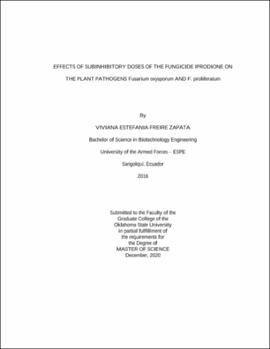| dc.contributor.advisor | Garzon, Carla | |
| dc.contributor.author | Freire Zapata, Viviana Estefania | |
| dc.date.accessioned | 2022-05-04T13:05:29Z | |
| dc.date.available | 2022-05-04T13:05:29Z | |
| dc.date.issued | 2020-12 | |
| dc.identifier.uri | https://hdl.handle.net/11244/335491 | |
| dc.description.abstract | Hormetic stimulatory responses have been widely reported in several economically important plant pathogens. Low doses of commonly applied fungicides can enhance fungal traits in vivo and in vitro conditions. However, little is known about the molecular mechanisms behind hormetic responses. During this study, the effects of subinhibitory doses of iprodione on the growth of Fusarium oxysporum and F. proliferatum in vitro and in vivo were examined. Changes in the relative expression of 5 candidate genes of F. proliferatum growing at the suppressive dose, maximum stimulation dose of iprodione and a fungicide-free control were determined using RT-qPCR. Moreover, changes in the gene expression of this fungus growing at the maximum stimulatory dose of iprodione and a fungicide-free control were analyzed using RNAseq data. The results showed that subinhibitory doses of iprodione stimulated the mycelial growth of both pathogens in vitro and in vivo. In vitro, F. oxysporum wild type displayed an average growth stimulation of 6.87% and F. proliferatum wild type displayed 8.21% stimulation at 24 hpi. On onion epidermis, F. oxysporum demonstrated an average stimulation of 24.66% at 48 hpi and 19.6 % at 72hpi. In the case of F. proliferatum, mycelial growth was 23.62% larger than the control at 24hpi, no hormetic responses were observed at 48 and 72hpi. Significant changes in the relative expression of FUM1, HOG1 and HSP70 were observed at the suppressive dose. No significant changes in the expression of the 5 candidate genes were observed at the hormetic dose. Finally, 177 genes were differentially expressed, 117 upregulated and 60 downregulated. Functional annotation of the DEGs revealed that 57 had signal peptides, 24 genes were identified as carbohydrate-active enzymes, 15 were putative fungal effectors and 4 DEGs encoded for secondary metabolites. Upregulated processes included carbohydrate metabolism, detoxification mediated by ABC transporters and cytochrome P450 enzymes. | |
| dc.format | application/pdf | |
| dc.language | en_US | |
| dc.rights | Copyright is held by the author who has granted the Oklahoma State University Library the non-exclusive right to share this material in its institutional repository. Contact Digital Library Services at lib-dls@okstate.edu or 405-744-9161 for the permission policy on the use, reproduction or distribution of this material. | |
| dc.title | Effects of subinhibitory doses of the fungicide iprodione on the plant pathogens Fusarium oxysporum and F. proliferatum | |
| dc.contributor.committeeMember | Marek, Stephen | |
| dc.contributor.committeeMember | Flores, Francisco | |
| dc.contributor.committeeMember | Melouk, Hassan | |
| osu.filename | FreireZapata_okstate_0664M_17018.pdf | |
| osu.accesstype | Open Access | |
| dc.type.genre | Thesis | |
| dc.type.material | Text | |
| dc.subject.keywords | fusarium | |
| dc.subject.keywords | hormesis | |
| dc.subject.keywords | hormetic mechanisms | |
| thesis.degree.discipline | Entomology and Plant Pathology | |
| thesis.degree.grantor | Oklahoma State University | |
